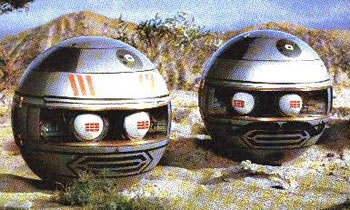Science Fiction
Dictionary
A B C D E F G H I J K L M N O P Q R S T U V W X Y Z
Smart Ball Android Spherical Robot

The Smart Ball is a small plastic spherical robot that you can control with your Bluetooth-capable Android phone. The interface that you use to control the Smart Ball is the simplest possible; tilt your cell phone in the direction that you want the ball to roll, and there it goes.
(Smart Ball video)
The balls are actually prototypes for a real commercial product, and were made by hacker group Gearbox. The Gearbox folks have already opened up the APIs (the parts that let programmers create apps to control the balls) and have been running hack weekends where people can come along and try them out.The Gearbox people are aiming for a price of around $25, and already have games planned or written.
SF fans (as well as fans of supermarionation) remember the early 1980's series The Terrahawks, which had spherical robots called Zeroids were used to fight the evil witch-like alien Zelda.

(Sargeant Major Zero and Zeroid 18)
Update 04-Jun-2025: Compare this item with the Ruum robot from The Ruum by Arthur Porges.
Jim Irwin had once worked with mercury, and for a second it seemed to him that a half-filled leather sack of the liquid metal had rolled into the clearing. For the quasi-spherical object moved with just such a weighty, fluid motion. But it was not leather; and what appeared at first a disgusting wartiness, turned out on closer scrutiny to be more like the functional projections of some outlandish mechanism. Whatever the thing was, he had little time to study it, for after the spheroid had whipped out and retracted a number of metal rods with bulbous, lens-like structures at their tips, it rolled towards him at a speed of about five miles an hour.
End update.
Roll over and click on these links to see more amazing spherical robots:
- Jollbot Robot Ball Jumps, Bounces And Rolls
Take a look at this Jollbot video for a better look at its unique rolling jumping gait. - Inflatable Spherical Robots May Explore Mars
The proposed devices would have a soccer ball-style surface, with hexagonal solar panels gathering energy. - Spherical Robot Lego Mindstorms NXT-Based
A pretty cool DIY project by Nils Völker done with a Lego Mindstorms NXT robot kit. - Spherical Soft Robots Use Shape Memory Alloys
...we employ soft actuators to controllably deform a robot body, enabling it to crawl and jump on rough terrain. - OrbSwarm Autonomous Spherical Robotics
Take a look as OrbSwarm bots roll around. - Rotundus Groundbot Robotic Spherical Guardian Video
GroundBot weighs just 25 kilograms and rolls easily on its special polycarbonate shell.
Scroll down for more stories in the same category. (Story submitted 8/8/2010)
Follow this kind of news @Technovelgy.| Email | RSS | Blog It | Stumble | del.icio.us | Digg | Reddit |
Would
you like to contribute a story tip?
It's easy:
Get the URL of the story, and the related sf author, and add
it here.
Comment/Join discussion ( 0 )
Related News Stories - (" Robotics ")
Artificial Skin For Robots Is Coming Right Along
'... an elastic, tinted material that had all the feel and appearance of human flesh and epidermis.' - Harl Vincent (1934)
Robot Guard Dog On Duty
I might also be thinking of K-9 from Doctor Who.
Wearable Artificial Fabric Muscles
'It is remarkable that the long leverages of their machines are in most cases actuated by a sort of sham musculature...' HG Wells, 1898.
Dancing Robots Taught Dance Moves
'A clockwork figure would be the thing for you...' Jerome K. Jerome, 1893.
Technovelgy (that's tech-novel-gee!) is devoted to the creative science inventions and ideas of sf authors. Look for the Invention Category that interests you, the Glossary, the Invention Timeline, or see what's New.
Science Fiction
Timeline
1600-1899
1900-1939
1940's 1950's
1960's 1970's
1980's 1990's
2000's 2010's
Current News
The Zapata Air Scooter Would Be Great In A Science Fiction Story
'Betty's slapdash style.'
Thermostabilized Wet Meat Product (NASA Prototype)
There are no orbiting Michelin stars. Yet.
Could Crystal Batteries Generate Power For Centuries?
'Power could be compressed thus into an inch-square cube of what looked like blue-white ice'
India Ponders Always-On Smartphone Location Tracking
'It is necessary... for your own protection.'
Amazon Will Send You Heinlein's Knockdown Cabin
'It's so light that you can set it up in five minutes by yourself...'
Is It Time To Forbid Human Driving?
'Heavy penalties... were to be applied to any one found driving manually-controlled machines.'
Replace The Smartphone With A Connected Edge Node For AI Inference
'Buy a Little Dingbat... electropen, wrist watch, pocketphone, pocket radio, billfold ... all in one.'
Artificial Skin For Robots Is Coming Right Along
'... an elastic, tinted material that had all the feel and appearance of human flesh and epidermis.'
Robot Guard Dog On Duty
I might also be thinking of K-9 from Doctor Who.
Wearable Artificial Fabric Muscles
'It is remarkable that the long leverages of their machines are in most cases actuated by a sort of sham musculature...'
BrainBridge Concept Transplant Of Human Head Proposed
'Briquet’s head seemed to think that to find and attach a new body to her head was as easy as to fit and sew a new dress.'
Google's Nano Banana Pro Presents Handwritten Math Solutions
'...copy was turned out in a charming and entirely feminine handwriting.'
Edible Meat-Like Fungus Like Barbara Hambly's Slunch?
'It was almost unheard of for slunch to spread that fast...'
Sunday Robotics 'Memo' Bot Has Unique Training Glove
'He then started hand movements of definite pattern...'
Woman Marries Computer, Vonnegut's Dream Comes True
'Men are made of protoplasm... Lasts forever.'
Natural Gait With Prosthetic Connected To Nervous System
'The leg was to function, in a way, as a servo-mechanism operated by Larry’s brain...'
